Text
Process Journal #9: Process Reflection
I think every stage of the creative problem solving process was important. However, for the sake of our 8 week project I felt that more time could have been spent on particular stages of the creative problem solving process. For example, I would have liked to spend more time on the Implement stage in order to full develop our prototypes and mockups.
If this project had a longer timeline, I would have added a test stage. Testing our product would be very helpful for further development before launching.
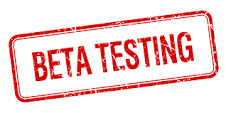
Below I have listed some exercises that should be mandatory for each part of the process:
1. Accept - All teammates must be on board with the commitment to the process and the acceptance of the subject matter. Teams should no move forward without all team agreement.
2. Analyze - Research should be gathered with outlets outside of the internet. Often times, blogs and secondary information are used more heavily than proven facts.
3. Define - Decide on a definition that you will actively solve.
4. Ideate - Set a time limit to the brainstorming session. Encourage any and all ideas even if they seem unattainable.
5. Select - There should be at least three separate ideas to choose from in order to properly execute the select stage.
6. Implement - Prototypes should be developed enough to test.
7. Evaluate - User, team, and peer evaluation should be included.
0 notes
Text
Process Journal#8: Evaluation
When it comes to evaluation, I tend to be very numbers driven. I like measurable success rather than qualitative or subjective terms used regarding the overall success. However, for our methods of implementation, qualitative feedback is going to be extremely helpful. I have broken down each stage of the creative problem solving process below and provided techniques for evaluating the success of each.
Accept: Did the group come to a consensus on the subject matter selection for the project? Did we all find ways to relate to the subject matter and have reason for solving problems within it? For our group, this was a short step of the process. When the Future of Work was presented in our first group meeting, our eye lit up and we all had personal stories to share for reasons why would we like to change the current state in which we work.
Analyze: We took a divergent approach to this stage. After our first meeting and deciding on the Future of Work as our topic, we began to collect articles, blogs, infographics, and beyond on the topic. We weren’t sure which particular problem we were aiming to solve so we pulled from all areas like disappearing jobs, automation, boredom, flexibility, autonomy, passion driven work, and international work. I felt this was a successful implementation of this stage because we were able to understand the variety of problems within the “Future of Work”. I might assess this further by noting if any additional problem areas were identified later in the process. What there something we missed that changed the overall direction of the project? Those questions might help me understand if this part of the process was successful.
Define: I might evaluate the success of the stage by comparing our definition to our final solution. Did we find the answer to our problem through our product? Are there any areas not addressed or missing? We did alter our problem definition midway through but I do not think that indicates any sort of failure but rather owning the iterative nature of this process.
Ideate: Our group used a collaborative brainstorming tool called MURAL for this stage. We were able to rapidly place ideas on virtual post it notes and then later move them around to categorize them. By the end of our Ideate stage we had three categories - Work on the go, passion projects, and collaborative tools. In future ideation stages, I might focus on developing three pitches rather than three categories. Our categories were spot on but we did not have specific pitches for each category. This shaped our select stage in using a Idea Potpourri.
Select: Throughout this phase, we were able to feel confident in our selection due to our selection methods of idea potpourri and polling the audience we are building this product for. Our survey results backed up our reasoning for this app and allowed us to feel like this could be a product people latch on to and changes the way we work. I think when you can find data or use analysis to help provide that your selection is justified and addresses your problem statement is a great way to measure success here.
Implement: If our audience understands our product and finds a reason to use it, I believe we can say our implementation was successful. For this project, I will be paying attention to the reaction of our presentation, the overall understanding of what our products does, and the types of questions we receive afterwards to measure success. Did we successfully present our product and its uses? Did we spark interest within the audience? Do they want to know more? At this stage in product development, I would strive to have a product and pitch that consumers can understand and see themselves using. Further down the line, when our product is ready for use we can evaluate success through the quantitative and qualitative results of our beta test.
Evaluate: If our individual evaluations of our stages are similar, I will feel confident in this process. It will show me that we operated as a cohesive group throughout each stage. I am also eager to receive evaluations from other teams as we are presenting this concept to an audience that could potentially use this product.
0 notes
Text
Conceptualize It : The Future of Work
What does your implementation look like?
Using our previous process journal posts as inspiration, we decided to create a style guide. Justin took the first steps of just looking at the the definition of impact, using the way the word was split up.

As a team, we came together and defined the brand mission, core principles, brand personality, and moodboard. These items would serve as the basis of how we run our operations, design, marketing, and more.

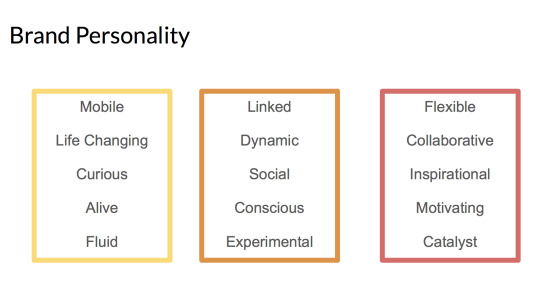
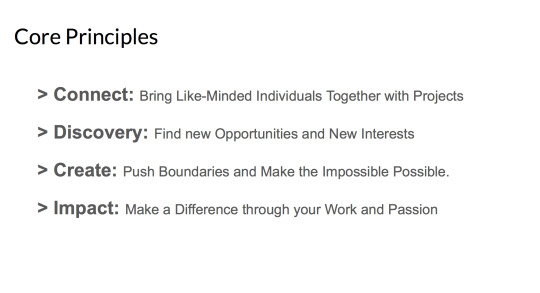
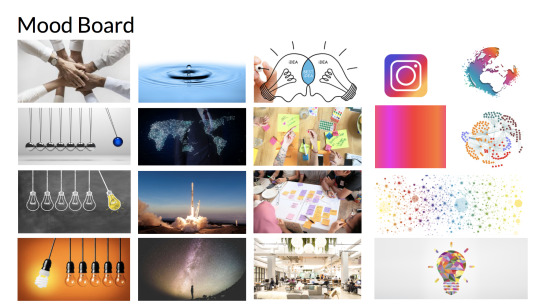
Before Alyssa started the design and mockups, the team also created a flow chart of what the user would see and how they would interact with the solution.

After this was finalized, Alyssa created mockups of the application and the user flow. Although the user would most likely start from the desktop, it made more sense to create the mobile version first and translate that to desktop rather than the other way around. As a team, we went through the first design iteration, seeing how we could make a few tweaks.
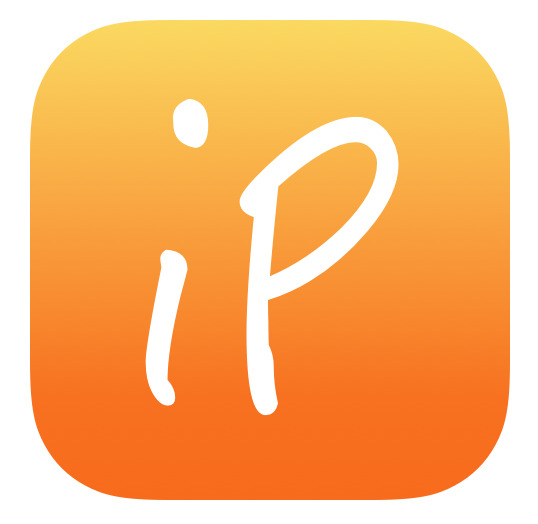
One example was how we transitioned the colors from a gradient of magenta (feeling like love) to a gradient of orange (feeling warmth). The team also made minor changes like matching the font of the header and box text in addition to the order which the content popped up. We had to keep in mind that the first version of the solution would just connect people to other individuals and passion projects. Later on, the solution would provide online collaboration tools or access to different API’s, making communication and seamless for the users.
How will people interact with it?
Our users would interact with our solution digitally first on the web (or on their smartphone if they live the on-the-go lifestyle). They may be searching for different jobs to pivot to or discover various ways to pursue their passion through their work. After discovering potential passion projects to work on, the user would apply and get connected to the individual or group that posted the position. The user would then be able to continue communicating with the other individual or group on their smartphones through the application. Both parties can communicate and agree upon how they will execute the project together. The user would either learn something new by working with others or contribute with their expertise and passion. After using the solution for various projects, individuals would then be able to see a list of previous projects they worked on and the current projects they are working.
Another way that the user would interact with the solution is by posting opportunities either as an individual or as an organization. After setting up their account, they could post the name of the project, some background information, and what type of positions are needed. Individuals would then apply to these postings and communication would start between the various parties, discussing how the project will be split up.
Through many projects, users could earn money by working on projects they are passionate about or apply their skills to non-profit projects.
vimeo
What are the processes or systems involved for how it functions?
Through Brian’s leadership, our team was able to develop the UX design of the process and system of our app and website platform. To see the live flow of the application, Alyssa utilized Adobe XD, testing various layouts and combinations. In order to make this solution go live, there are a few things that need to be taken into consideration from the technology side. Some design solutions that could be used to create the final mockups could either be Adobe Illustrator or Sketch. To build the website, the team could either build the code from scratch or build off a framework like bootstrap. The pros of using bootstrap would be keeping the design liquid and mobile responsive. Javascript and python would be a few languages that would help run the solution. Leading to the mobile development, we think making the application iOS specific first would make sense since the majority of our target market uses an iPhone. Later on the roadmap as our product grows globally, we would create an android specific application Since this application is data input heavy, we would need to create a reliable infrastructure. Although on the pricier side, AWS (Amazon Web Services) would be the most ideal, being able to store and process data at a fast rate. They would also maintain the servers needed to store and run the data. Later on in the roadmap, these servers would be capable to run Machine Learning algorithms (AI).
With so much data being involved, the data tables would need to be structured correctly. One thing to take into consideration is how the data will be used from the user’s needs and the organization’s needs. The data may look the same but the intentions of the data need to be specified in order to make the solution work seamless.
The website would need a domain and be hosted while the mobile application would need to be posted into the app store in order for the users to reach the solution.
The Pivotor - Jane
Jane is the VP of finance at a large fortune 500 company. She started her career there straight out of college and has built her way to the top for over 15 years. Jane knows that she is good at running the company and its finances but knows that there is only so little she has left to learn. She wonders what her life would have been like if she pursued her passion, drawing and designing graphics. During her free time, Jane does design different art pieces and share it with her family. After constant feedback from her family about pursuing her passion, Jane decides to look at potential ways to spend more time designing outside of work.
One day, she googles and discovers imPACT, a solution that allows you to connect with others and pursue your passion project. Exploring more of the front page, she sees the option to create a profile, which entails to some simple information like a profile picture and an introduction. There are some options to include some of her social media links like LinkedIn and Twitter. She puts that her professional experience is in finance but her passion is in design. Below this, she finds a empty gallery where she can showcase her previous artwork. After finishing her profile, she searches the keyword “design”, discovering a wide range of opportunities to contribute to.
One project that real captures her attention is web design through a small e-commerce startup, but she has no experience at all in this particular field. Out of curiosity, Jane applies for this opportunity, and is automatically connected to the startup and is able to introduce herself and why she is interested in a chat. Moments later, she receives a response from one of the representatives. They looked at her profile and are very impressed by her artwork. Seeing her potential, the startup offers her the opportunity to work and learn from one of their UX designers since they need a lot of help.
Excited, both sides connect on the best practices for work and communication, slowly transitioning away from the app chat. The startup closes the position and Jane’s profile now shows her working on the current project. Their agreement is that she can work on it after work hours and on the weekends. Jane now has the opportunity to continue her stable job while learning web design after hours.
Once the web design project is over, Jane’s profile shows the previous project and the web design she worked on. Thankful for the opportunity, she realizes that her company needs to revamp their operations and utilization. Looking for a operations consultant, she asks her team to post a position on imPACT, looking for someone who is passionate about optimization and business strategy. They find a match and go through the same process that Jane went through previously.
Who are the primary stakeholders involved and what is their perspective on the solution implementation?
Individual Freelancers - The opportunity to participate in a project aligned with their passion. The ability to pivot careers with a mentored learning experience without the heavy risk.
Corporate Organizations- The opportunity to discover new talent, to assemble new teams of people with new ideas and to execute projects that people are passionate about.
Non-Profit Organizations- The ability to outsource work from high- profiled creatives and freelancers that are passionate about the organizations mission and work.
Start-up Organizations- Low Risk outsourcing of talent to achieve tasks and projects that are outside the initial budget constraints of an organization.
0 notes
Text
Process Journal #7: Implementation
Reflect on the methods and techniques that your group plans to use to communicate the ways that your project should be implemented and summarise those thoughts in a new post in your process journal. How do you most effectively pitch your idea to various stakeholders? How do you visually communicate the objects, environments, systems, processes, and interactions involved in your project implementation?

To kick off this process, we went back to MURAL. We imported the business canvas and broke out each section into sticky notes that we could each place specific ideas for that area of the business model. We did this separately and then came together to discuss each post it and how it would fit or not fit into the model. This was my first time working on a collaborative business model and it made it A LOT easier. It’s a great way to validate or eliminate ideas for your business idea.
At one point in the process, we talked to Grant who shared his own stories of his career - the ups and the downs. We realized that most people we have talked to about this topic have a story to tell. We will use these stories to drive empathy within our pitches.
Our implementation plan will have several steps and include several different visual techniques for pitching to stakeholders. To start off, we are going to need to raise capital in order to get this project off the ground. The expenses we have preliminarily calculated include personnel, databases, servers, advertising, development, physical space and beyond. In order to do so we will need to build a VC specific deck that includes cost structures and planned revenue streams, wireframes or mock ups of the website/app, user personas, and highlight the benefits of the individual user and larger corporations. We will lay out exactly how we plan to use their investment and our desired results in order to build trust within our investors.

Additional visual components that will help us pitch our idea/business model include:
Wireframing the website and application to show how users will experience this service. We will show the B2B experience and the B2C experience and how connections are formed. This particular visual aid will be helpful when selling the experience to users.
Illustrating the UX Experience will be a great visual to aid in our presentations. How will the app look?
Creating the business model Road Map will allow stakeholders and investors to see our short term and long term plans. A service like this model will take several stages in order to successfully implement and reduce overall risk. We will certainly start out with a facilitated beta test in order to identify any problematic areas.
Forming a Budget will also be extremely helpful for pitching to investors. How much capital do we need to get started? How much will we need once we hit our first benchmarks?
There is no doubt that this business model carries risks and additional opportunities. We will highlight these through a thorough SWOT Analysis. We want to be transparent about our analysis.
Forming our brand will also be crucial. We will work on logo designs, color palettes, mission statements, and beyond in order to form a brand our users can identify with!
1 note
·
View note
Text
Business Model Canvas: The Future of Work
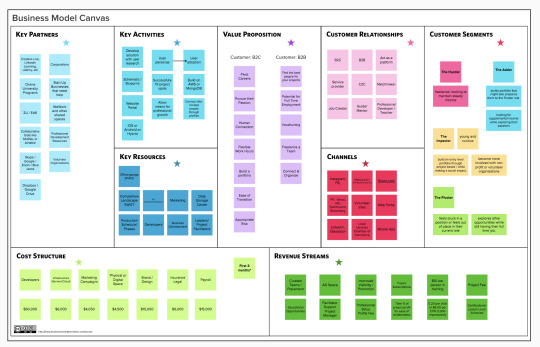
Key Partners:
In order for our business model to function optimally, we will seek strategic partners. These partners include corporations looking for part time help, start up businesses looking to build strong teams, shared spaces where freelancers can often be found like WeWork, and volunteer organizations. These types of partners will provide projects for our future users and help build the reputation of our brand.
Key Partners are important for our early stages and long term plans. Strategically we plan to bring on Corporations and Startups who are committed to creating projects for freelanced assembled teams to join in the beta phase. In addition, work spaces like WeWork may be inclined to offer their members this opportunity to be an early adopter. We recognize that some of our competitors may actually be partners in the future as the entry point and exit point to our platform. There is possibility to align with online educational spaces, as well as incorporate the collaborative digital tools into and accessible by our platform.
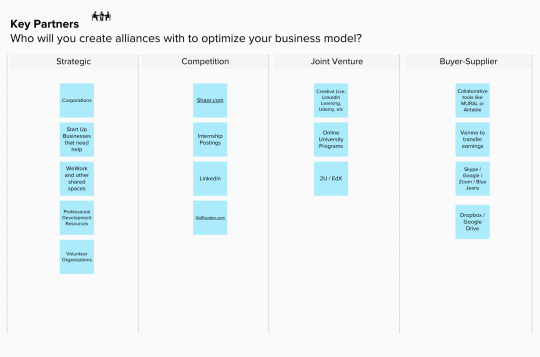
Key Activities:
To make this business successful, there are a few key activities we would need to accomplish. In order to make the solution successful, the team would need to develop with user research and feedback incorporated. Understanding the mindset of our target market and potential users will help us create user personas and develop a consumer-centric solution. Having a consumer-centric solution will help us with user adoption in the long term. It would also be key for us to create a services blueprint, showing and helping us understand when our consumers use our solution and what steps are needed to give them the best experience. This can also show us some resources we can share across our services or the pain points that need to be addressed. After some discussion, we see our users understanding the solution and its services through their desktop. Once they have made their connection with their passion project or company, they can communicate on the go using our application. We need to make sure that the solution not only allows people to connect with their passion projects, but also provides them opportunities to grow professionally. Other key activities to ensure is that the user data and software is ran on reliable servers like AWS, design a UX that empowers the users, connect like-minded people through profiles, and set up a our business account (banking, HR, team infrastructure, and more).

Key Resources:
We have decided on Key Resources that will allow our business to scale accordingly. On the onset, we will need physical resources like a creative space whether digital or physical. We will also need a domain and data storage center. From an IP standpoint we will need to implement Machine Learning, adjust for Network Growth, formulate a strategic plan, create a Production Schedule in Phases and perform an Competitive Landscape/ SWOT. The Human talent and resources will be developers both for the technical and business development, marketers, operations/ finance/ HR, as well as project leaders and facilitators. Financially, we will require a bank account, funding both personally, as well as form VCs. There is potential for some crowdfunding opportunities for some of the non-profit activities.
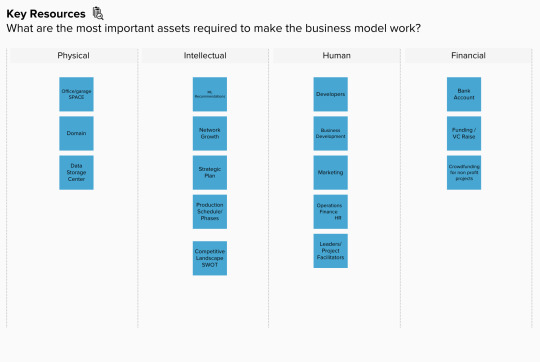
Value Proposition:
The Value Proposition that our app and platform provides to customers is two-fold. One customer is the individual freelancer; we will be enabling them to pivot careers, pursue their passions, find connections with other team members/mentors, build their portfolios, transition with ease and take appropriate risk. For the Business organizations, we will connect them with the best talent for their project, headhunt potential full-time employees on trial run, freelance a team and connect and organize. Great value can be awarded to all parties involved.
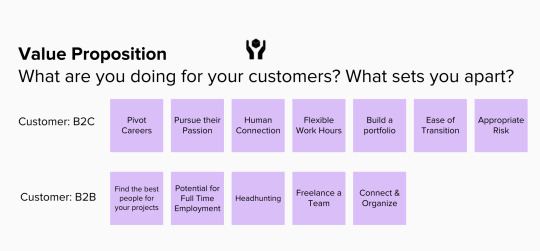
Customer Relations:
The expected Customer relationships are as follows: Our Business to others Businesses, Our Business to the Individual User and Individual users to connect with each other. We act as a platform to create jobs, matchmaker, guide/ mentor, as well as perform the role of teacher and professional developer through training that we provide in future phases.

Channels:
Since imPACT is a business that focuses on remote collaborative work that brings like minded people together to pursue their passions we will rely on remote collaborative platforms to target our audience. We will certainly be advertising on social media channels like Facebook, Instagram, Twitter, and LinkedIn. In addition to the tradition social media / advertising platforms that help target ads to the correct audience we will also utilize blogging or channels platforms like Medium.com.
We will also need a sales team to form and build relationships with larger corporations, non profit organization, freelancers, and starts up that might benefit from using a service like ours. We will avoid cold calling but rather generate prospective partners or users through targeted advertising. Once a few key relationships are established, we will start to lean on our referral system to continue to grow our user database.
We can also utilize job posting websites like Shapr.com and LinkedIn.com to advertise the possibility of owning your own “small business” through managing several small projects you are passionate about. This will be a great tool for entry level employees looking to find their passion and build a portfolio through exploration.
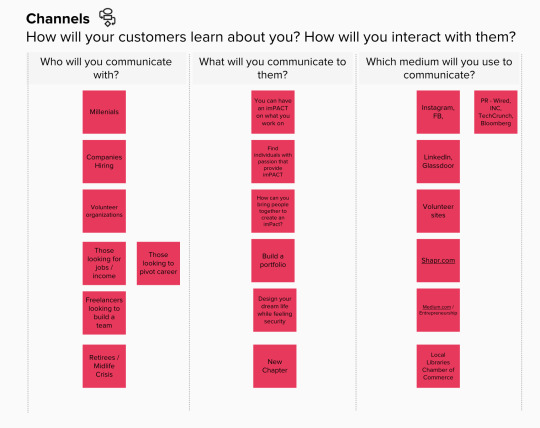
Customer Segmentation:
Our target audience includes several categories. We have identified these personas as the following: The Hustler, The Adder, The Pivoter, The Impactful.
The Hustler is a freelancer that is looking to maintain steady income through several projects.
The Adder is looking for supplemental income while exploring their passions and building a portfolio that might also prepare them to move into the Pivotor role.
The Pivoter is someone who feels stuck in a position or feels out of place in their current role and wants to explore other opportunities while still having the security of their full time job.
The Impactor is someone who is looking to become more involved with non profit or volunteer organizations. The Impactor might be young and curious and can start to build an entry level portfolio through project based work while making a social impact.
In addition to these user personas, we are also targeting larger corporations, non profit organizations, start ups, or freelancers that could benefit from using our platform to build strong teams and help their project keep momentum. We will help these project facilitators connect to their strongest teams.
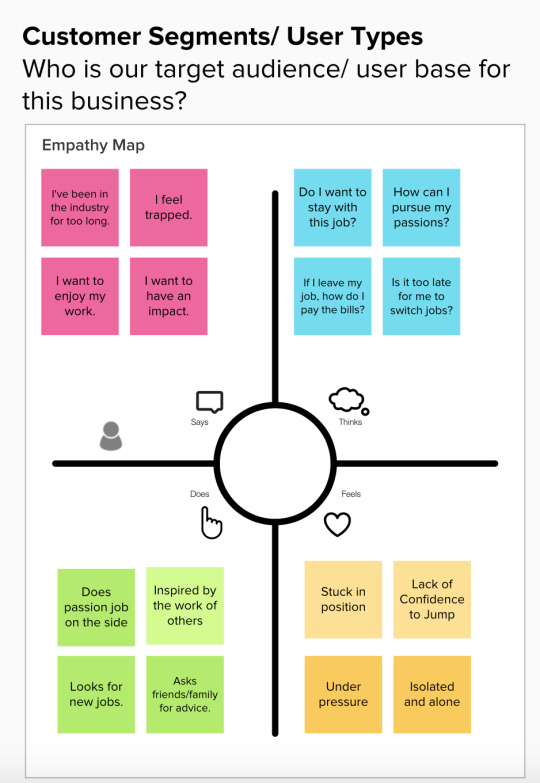
Cost Structure:
There are some costs that the team needs to consider before starting this endeavor. In the beginning (first three months), we would need full-stack developers to help create the solution on desktop and mobile. To create a PoC (Proof of Concept), we may need 3 full-stack developers, costing about $60,000. To set up our reliable technology stack and infrastructure (like databases and servers), we would need about $6,000. We can work out of an office or co-working space like WeWork for about $4,500. The marketing campaigns would cost about $4,050 if our goal was to reach out to 15,000 users. Business insurance would be about $6,000, branding and design around $15,000, and payroll for other business functions (operations, finance, hr) would be another $15,000. Overall, the initial costs to start within the first three months would be about $110,550.
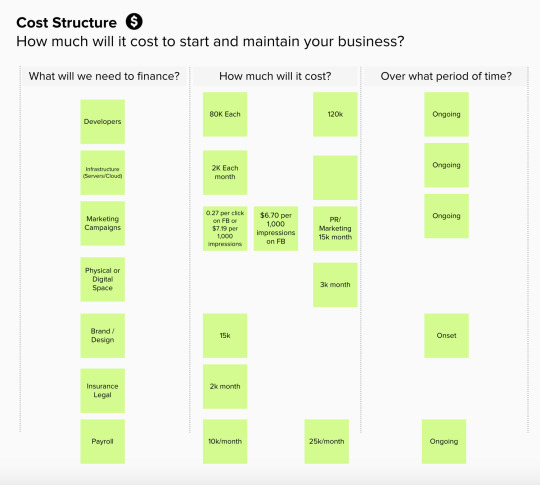
Revenue Streams:
Revenue Streams are achieved through the following: A fee to the business organization for curating and placing individual freelancers. A fee to the individual freelancer for educational opportunities. There is ad revenue on both the website and the app. In addition, there will be fees for additional support for the business organization for project management until our AI is fully developed and automated- this could be a concierge type of service in future phases. There will also be fees for professional setup for both the individual freelancer, as well as the business organization. All these fees will be established and allow us to use discounts and waived fees as promotion and marketing. Certifications and improved visibility fees are also things that can be implemented at later phases with subscriptions for the serial freelancer. Variables that could affect the fees are discounts and leapfrogging/ cutting out the app as a middle conduit.
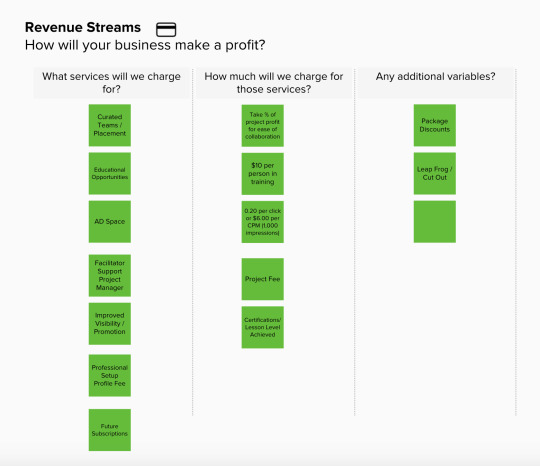
0 notes
Text
Process Journal #6: Selection
As mentioned in our group post, we really had three major methods for the selection stage; prompted question, idea potpourri, and a poll/survey.
During the brainstorming stage we went through and starred our top three ideas. When we circled back to the selection stage we realized that our top three ideas (Passion projects, working on the go, and collaborative tools) could all be lumped together into one better idea. It would not be enough to simply creative a collaborative tool or methods for working on the go to truly alter the future of work. Instead we want to create a collaborative tool that is meant for working on the go AND connects people to projects or assignments they are passionate about. This is where the potpourri method came into play.
From there, Justin asked Brian and I the same question - “What motivates the people you work with?” We both responded similarly in that we discussed motivation coming from a project, product, or service that we are passionate about or motivation coming from a place that allows us to have a true impact. Nobody likes to feel robotic - most people want to make a big splash in whatever they do. This is our target group. They want recognition and they want to make a difference and we want to help them do so.
At that point, Justin said “imPACT” as an idea for the name of our service. We then started spitballing ways to make this happen. We talked about users, the purpose, what problem it solved, and the fact that this would not only be for Gen Z but all generations in the workforce as well. This realization caused us to revisit our problem definition since it was originally specific to Gen Z, a truly iterative process.
In order to hone in on what today’s workforce REALLY wants we turned to the polling technique. We asked questions about motivation, preferred schedule, preferred location, and beyond. From this survey we were able to draw some interesting conclusions, as stated in our group post. You can see the results in the images the follow. Our general conclusion is that most people want to work on passion projects, have flexible work hours, and work on professional growth or development. These results allowed us to expand on some ideas for our app and tools to include within it.
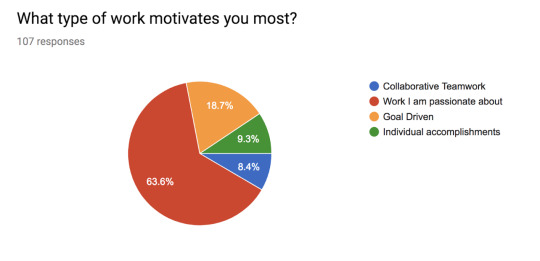
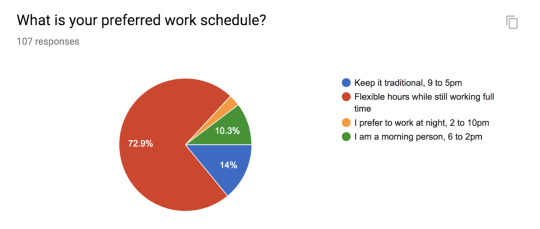
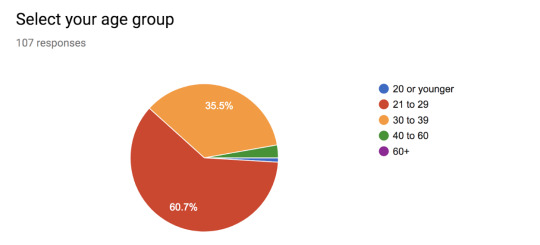
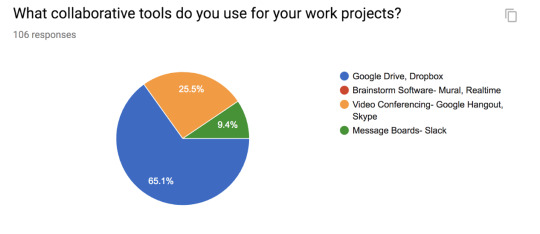
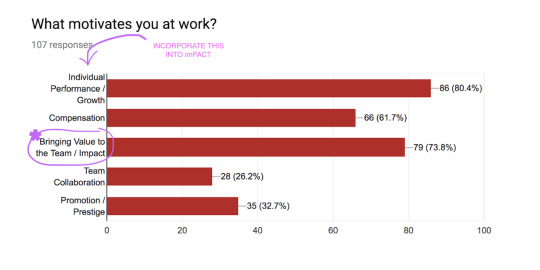
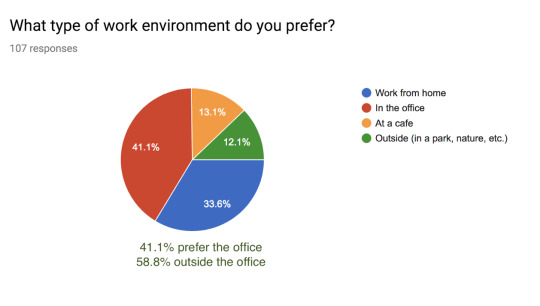
As far as debating goes - we honestly kept this very conversational. We are a group that likes to hear each person and comment afterwards. I do not feel that any person was so strongly tied to a particular idea which made the idea potpourri a welcomed technique. All in all, I am excited for the next stage of the process!
0 notes
Text
Choosing a Solution

What criteria did you use to select the solution?
We used the following methodology to arrive at our solution:
Prompted Question: “What motivates your peers at work?”
Idea Potpourri
Poll / Survey
We realized that with all three of our solutions, we were able to combine all of the ideas and target multiple generations rather than only focusing on Generation Z. We then took an iterative approach and altered our problem definition from “As Gen Z enters the workforce, employee values and technology will evolve. How can we adjust how we work today to better prepare for the next generation?” to “As employee values and technology evolve, how can we alter the current state of the workforce to better cater to our passions and non-traditional work environments?” Through our conversations, as mentioned below, we realized that aligning our work with our passion is not only something the younger generations value but it common among several generations and is already seen within some of our neighboring countries.
How do the pragmatic and logistical concerns around implementation affect the selection of your solution?
Our solution is going to require expertise, imagination and curiosity. We will be able to implement and create an app that will be within our budget and we are aware that if additional funds are needed we will perform rounds of fundraising. Through proof of product, we understand that there are several variations of social networks that already exist. For that reason, developing a social network / collaborative space for passion projects will not be a large hurdle to overcome - it will simply be a niche network and unique interface. Our various SELECTION methods, we were able to arrive at a very focused and direct solution that fits within a reworked problem question. The pragmatic and logistical concerns were nearly abolished through our 3 methods of selection.
How do you deal with compromises and coming to a consensus regarding the solution decision?
Our Potpourri Conversation eliminated any individual allegiances we may have had prior to this discussion. Our final solution is a blend of our top 3 ideas.
During our selection process, we decided to ask ourselves what motivates our peers at work? This was our Prompted Question Exercise. After each talking about our industries and how people in different roles work, we noticed that the common theme was people wanting to having an impact. To test if our hypothesis was correct, we created a Poll. Within the poll, we decided to create questions to see if people cared about working on passion projects and what their passions were. To get a variety of users, we each asked people in our fields to answer the question (Justin with design, Alyssa with education and tech, Brian with enterprise and tech) along with asking the cohort. From our 107 responses, we found out that 63.6% of our participants were motivated by work they were passion about. Majority of our participants were between the ages of 21-39, being closely split between working in the office (41.1%) and away (58.8%). Overall, it was a close match between people being motivated for individual growth (80.4%) vs bringing impact (73.8%), showing us that both aspects should be part of the solution.

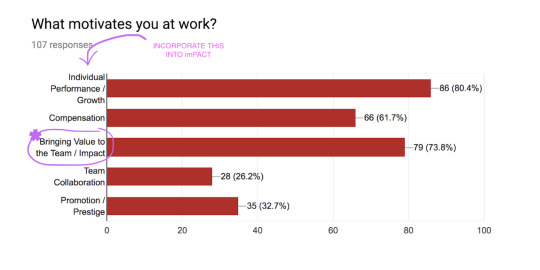
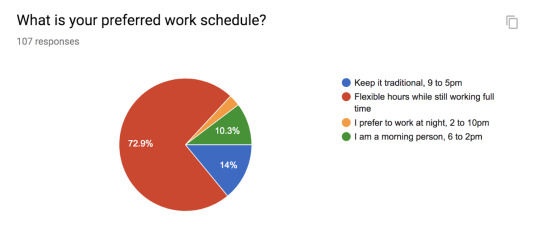
SELECTED SOLUTION: An app that matches users with passion projects that are posted by an organization or freelancers (non-profits, corporate research & development teams, government agencies, etc) where IMPACT is the end result. Users form PACTS with other users in remote and digital collaboration. imPACT can be rewarded through accomplishment, as well as other incentives based on the budget of the posting organization. imPACT can be used as a supplemental or primary income source. imPACT can be used to learn and mentor others through collaboration. imPACT is collaboration on the go.
APP Name: imPACT
0 notes
Text
Process Journal #5 : Ideation

Brainstorming in remote groups can be difficult but with Brian’s experience with using MURAL, a collaborative brainstorming software, we were able to dive right in after a quick tutorial. Using this software while also communicating in Google Hangouts made it feel like we were brainstorming in the same room. The ideation or brainstorming part of the process is typically the most exciting stage for me. I like thinking about any an all possibilities and feeding off of each other to expand on smaller ideas.
Before this ideation session, I had never heard of MURAL. Oddly enough, MURAL itself helps us prepare for collaborating in the future when most teams will include remote teammates as flexible work schedules and office locations become more important to our future generations.
What ideas were the outcome of your group brainstorming exercise?
Our ideas ranged from feelings to values to actual products. We talk about anything from “autonomy” to “WiFi on the GO”. We were, at times, very blue sky but were also able to get more specific in some areas. In turn, our ideas morphed into a combination of ideas as we continued to brainstorm.
It was extremely helpful to brainstorm and get all of our ideas down on virtual sticky notes and then take a BREAK, and a rather healthy one. We then came back and discussed our post-it notes and expanded where needed.
What were some of the standout ideas and discussion-points that came out of the debriefing session?
We talked a lot about placing employees of today and employees of the future within passion projects - providing the feeling of autonomy, accountability, and a sense of purpose. In addition to passion projects, developing more collaborative tools that allow people to work remotely will also help align with the value of our next generation and adjust to changing values of our current workforce. The ideas that stood out to us the most not only solve the problem of preparing for Gen Z but also help improve the way we work for millenials and beyond as well. Wanting flexibility and a sense of worth is not a generational phenomenon but something we can all align with.
0 notes
Text
Group Brainstorming and Ideation Session
Subject: Future of Work
Using your problem definition, come to a consensus on what your idea-generating question should be. While you brainstorm with your team, be sure to record everyone’s ideas.
Team Brainstorm Recording
vimeo
Observe and visualize your brainstorming process (Do you do it remotely? What collaboration software do you use? Are you writing, drawing, or something else? How does everyone feel?)
Brainstorm Session
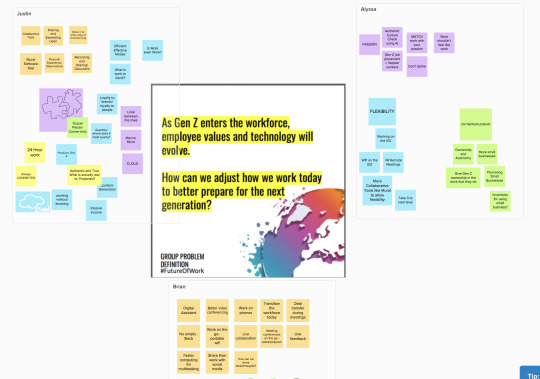
During our brainstorming process, one of our peers brought up a different way to brainstorm remotely. Sharing the software called Mural, we were able to brainstorm together online. Mural allowed us to post what our idea-generating question should be.
As Gen Z enters the workforce, employee values and technology will evolve. How can we adjust how we work today to better prepare for the next generation?
By brainstorming live, we could each have our sections, writing or drawing out our own thoughts using different colored post-its. It took a few minutes for everyone to get started and learn the software, but soon enough, we were all silent. Everyone was pretty optimistic about trying to use this new application. Although it was our first time using this tool together, we were able to experience brainstorming together without being in the same room.
Once your brainstorming session is over, take a little time to look at the ideas that you have generated as a group and attempt to make an effort to organize them in some logical fashion. Discuss some of your favorite ideas from each other and how you could combine different ideas in various ways.
After our initial brainstorm, we broke our ideas and post-it notes into themes: Work Cultures, Resources and Tools, and Workflow.
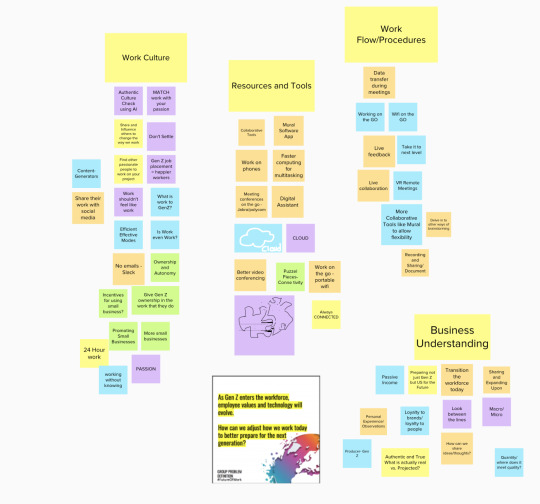
From there we went through and talked about each of the post-its. So far some of our favorites includeremote passion project placement for Gen Z, better collaborative tools, and consistent access to work and WiFi while on the go. All of these ideas really tie back to our problem statement of better preparing for Gen Z as they enter the workforce but they also help address how our current workforce will adapt in the way that we work. These ideas could even help older generations find jobs or passion projects to work on as we see the jobs of today disappear.
A lot of our ideas were results or affected by future technology and how work behaviors may changed for Gen Z. With this process, we are confident that we will arrive at some selection in the upcoming section.
0 notes
Text
Process Journal #4: Definition
I think the most important thing to note here is that the variety of problems that lie within the “Future of Work” can be overwhelming. In the beginning, we all agreed that this would be our subject matter but, to be honest, I had no idea the amount of problems I would discover. I feel like my group members felt the same. For that reason, we wrote our own individual problem definitions and explored our definitions further.

Once we came together to share our individual definitions and additional findings it was extremely helpful to talk about the similarities and difference within our own definitions. Understanding different perspectives of our subject matter allowed us to eventually come up with a hybrid definition.
We each noticed that our future generations will be centered around this shift in how and where we work. They are a generation of changing values and expectations for their work and for themselves. With each generation comes changes and adaptations to the way we work and the fields we work in. Our current workforce and employers will need to adapt in order to evolve.
As soon as we honed in on Generation Z, we began to think about specific areas that will be impacted like the elimination of specific jobs, how and where we work, and where we place our values. We then decided we want to address the problem by creating tools and technologies to better prepare the workforce for the upcoming generations.
This process was pretty smooth. It was an easy, relatable a topic that we will all be impacted by!
0 notes
Text
Group Problem Definition
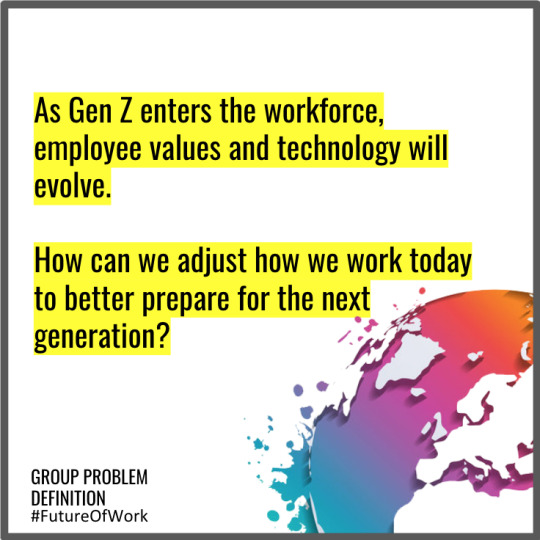
Individual Definitions:
Alyssa:
Gen Z: Generation Z will demand flexibility, security, and individuality - the demands of the workplace will change as Gen Z enters the workforce.
How can be better equip companies to be more appealing to our future generations?
Millennial managers appear to be the most worried about company culture
Corbin says that it’s necessary for managers of all generations to embrace using more technologyas Gen Z enters the workforce.
Despite their entrepreneurial nature, work-life balance and job security are the two career goals most important to this generation.
Brian:
Communication: How do we leverage technology in the future to bridge the gap of communication between the workforce?
If tech/AI take over the jobs of those in the IT/customer service sector, what can those people shift to?
https://www.forbes.com/sites/shephyken/2017/11/26/ai-is-super-charging-the-customer-service-world/#20ce4c004f04
https://www.ibm.com/blogs/watson/2017/10/10-reasons-ai-powered-automated-customer-service-future/
Justin:
Education and Preparedness/Training:
What tools and skills are needed to prepare the next workforce? What are these new jobs/ positions and have they been defined and shared? What jobs/ positions are going to be automated- has this been shared? Can education and training be implemented in the Primary and Secondary levels?
What jobs are at risk?
https://www.bloomberg.com/graphics/2017-jobs-automation-risk/
Similarities, Patterns, Differences, Outliers
Similarities: All individual problem definitions focus on our future workforce that includes Generation Z. Each problem definition is also thinking about how technology can help us but also the effect that technology has on our work. What jobs will need to be replaced? What communication tools and training can help companies facilitate future workforce Gen Z?
Patterns: Looking to the the next generation of our workforce. Technologies advancements and developments effect. How will our future workforce look like with the growth of technology?
Differences: Each one of us looked at technology shifting how a particular industry functions. We were seeing technology affecting different age groups with different impact. Some of our definitions are more specific towards solving a specific problem and other definitions stay more broad solving problems across various industries.
Outliers: Looking to education to prepare earlier generations for the future of work.
Extra Notes
What are GenZ wants and needs?
What forms of technology are Gen Z using?
Entrepreneurship
Work life balance
Job Security
As the Customer Service Industry is becoming extinct, how are new ways that companies can create jobs for Gen Z?
Company Culture
Flexibility
Communication between work force
Leverage Technology
Customer Service Industry
Machine- sounds like
Customer Service Jobs - Lessen
0 notes
Text
Conjunction Junction

My dog is mostly grey and white and has a few brown and black spots. Blu has one blue eye and one brown eye. Blu loves to chase the frisbee and sit by the fire in the summer. He loves his toys and his food, he really loves his food. He goes crazy when you say “squirrel!” and “kitty kitty”.
&
My dog is mostly grey but has a white stomach with a few spots. His eyes are beautiful but they are special because they are two different colors. Blu loves to chase frisbees but also love sitting by the fire after a long day of camping. He loves his toys but he loves his food more. He is usually pretty calm but he goes crazy when you say “squirrel” or “kitty kitty”.

These records are old and new. Some of them were my mothers that she gave to me as a gift and some of them are albums I bought. They includes all types of music genres and many different decades of music. They include The Beatles and Amy Winehouse. They include Willie Nelson and The Doors.
&
Some of these records are old but in good shape. They are mostly a gift from my mom but Connor and I combined our collection as well. Most of them are artists popular in the 70s but we do have some newer artists. They include Willie Nelson but not Billy Rae Cyrus. They include The Beatles but not Selena Gomez.

Photography is fun and adventurous. It allows me to meet new people and see new places. I love to volunteer my photography for non profit organizations and fun shoots with friends. Through photography I have been able to visit the Olympic Peninsula and Hawaii and Oregon and California and soon the Adirondacks in NY.
&
Photography is fun but not when you have tough clients. It allows me to meet so many new people but its often years before I see them again, especially if travel is required. I love to volunteer my photography but I wish I had more time to shoot more often! Through photography I have been able to visit several different states but nothing international yet!

Hiking is spending time outdoors and enjoying it. Hiking is for peaceful conversations with your friends and with yourself. Hiking is a great way to exercise the dogs and clear your mind. Hiking can make you think things like “I must be at the top” and “just one more mile”.
&
Hiking is spending time outdoors but not complaining. Hiking is great for having a peaceful conversation with your mind but its also a lot of fun with friends. Hiking is a great way to exercise the dogs but too much can hurt their paws. Hiking can make you think things like “I must be at the top” but then you see the next highest tree.

Teamwork is challenging and rewarding. Communication and patience are very important for cohesive teams. Teamwork requires trust and a willingness to speak up.
&
Teamwork is challenging but the final product is usually so much better than you imagined it would be. Communication is very important but you need to start with buy in from each team member. Teamworks requires trust but has no room for impatience.
0 notes
Text
Morphological Analysis of The Future of Work

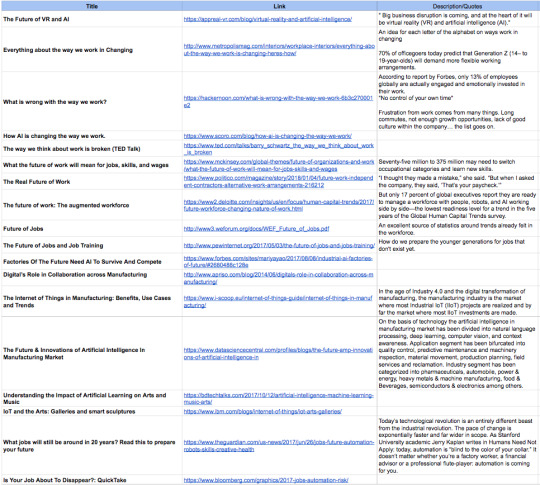
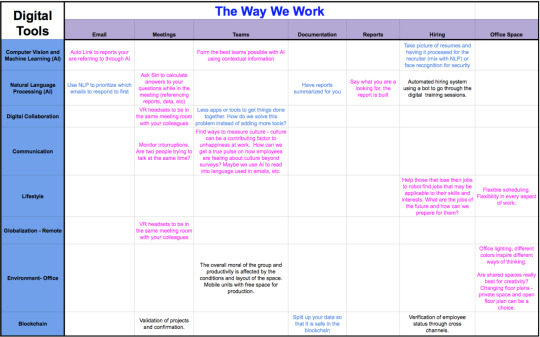
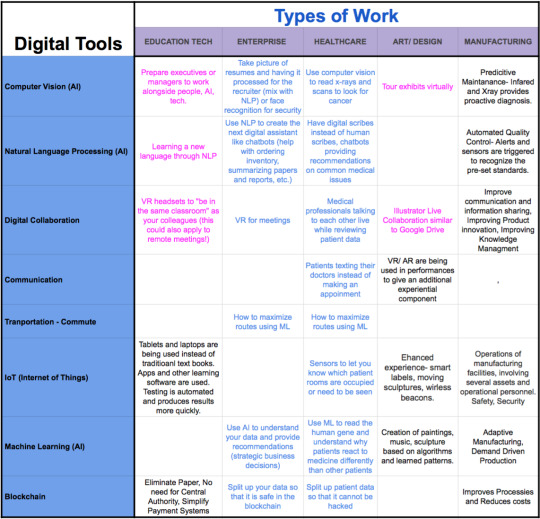
The team approached this assignment by doing a morphological analysis on the future of work. We chose to create two charts, one reflecting how technology affects certain industries and the other showing the impact of technology to common team structure. By doing both, this helped open our minds to the possibilities of what work can be done in the future with the help of technology. Some of our input came from our own industry knowledge while other comments came from researching how jobs and industries will be affected in the future. This exercise showed us that change is inevitable, but we can push the status quo of how work is traditionally being done everyday.
0 notes
Text
Defining Analysis

This week I tried to explore the “Future of Work” in a few specific way. Of course, the “future of work” is a trendy catchphrase so the internet is a great place to pull articles on this topic - whether it be about the value we find (or do not find) in the work that we do, the flexibility of hours and location, or addressing the problem of how we will work alongside the technology we developed. There are several problems that can be addressed with the way that we work right now versus what will be demanded or expected in the future.
Aside from the internet, I tried to immerse myself in more futuristic work spaces. I tend to try different coffee shops around the city each Sunday. Coffee shops and shared spaces are becoming the norm for remote work. With every place I visit, I am always curious what the other people around me are “working” on. Most have computers and are in their own little world. Often times the type of work changes with the coffee shop. For instance, the picture above is a coffee shop that focuses on the development of non profit organizations and even has a collaborative space you can use for free if you are launching a non profit or ideating in that realm.
Lastly, I looked to my own work environment to try and identify problems that must be solved in order to excel as a business in the future. For instance, how can we better manage different time zones? What technology can we adopt in order to more more effectively? What job duties might be coming as technology reduces the need for other positions?
So far the most interesting things I have discovered pertaining to the future of work are as follows:
Generation Z will demand more flexibility in how and when we work (can’t wait!)
Most executives are not prepared to work alongside technology advancements
The value we find in what we do is becoming more and more important
We need to prepare for jobs that do not even exist yet - how?!
Many jobs we see today will no longer exist
0 notes
Photo
“Be Yourself”
Typefaces talk.

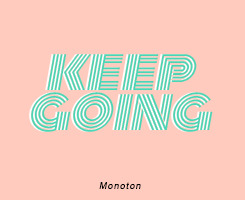






Please, like or reblog if you download it
Jezebel Alt
Monoton
Tondu
Bebas neue
Chunkfive ex
Thickhead
FHA sing devine
Cooper black
4K notes
·
View notes
Text
Picturing Success
What would accomplishing your goal be like?

What would be the immediately expected results of the best case scenario?
A final product/solution that we can truly bring to fruition to address a problem within the “Future of Work”
Who will be benefitting from your success?
Employers, employers, entrepreneurs, freelancers - hopefully everyone impacted by “work”. But our target market may get more narrow as we more clearly define the problem we are hoping to solve.
What positive impact will you be making locally and globally through your success?
Enhancing how we experience work! Considering overall health before productivity and revenue.
What kind of rewards could come from the success of your undertaking?
This one is for Brian. We promised him ice cream if we are a successful and happy group. But really, some many rewards could be coming our way! New business partners, new business ideas, a new perspective on the subject matter, meaningful work, cash money, new friends!

Do you expect to get a product back from this undertaking? Will there be some monetary reward?
I am not expecting it but I am striving to create a product that can actually come to fruition and become profitable!
How will this aid in furthering your career?
Mastering the art of group work and creative/design thinking will help me transition into a position that allows me to further utilize creative problem solving, testing the norms, and foster innovation. It will help me to have patience with group projects and find the best ways to collaborate. It will help me think about my day to day experience at work and what might make it even better!

What are your motivating factors for succeeding?
I am intrinsically motivated. I like solving problems in general. Whether it be planning out a crazy busy day or larger problems like, The Future of Work. I also do not want to let my group down. I know we are counting on each other and I would never want to be the person that does not contribute enough.
What makes you interested in the problem in the first place?
Most people I know work in some way or another. This a problem that people have been complaining about for decades. It’s a problem that impacts A LOT of people.
“I work too much.”
“There’s not enough time in the day!”
“My boss is the worst.”
What do you think is compelling about seeing the problem-solving endeavor to its end result?
I have never taken this much time on each stage of the problem solving process. I bet I will on cover some techniques that I can apply outside of this project that will ultimately help with future problems to solve. I like knowing that we WILL come up with a solution, even if that means testing the solution and revisiting it for adjustments. The process does not give us a choice!
What level of investment do you have in the solution succeeding?
Pursuing a masters degree is exciting for me. I was not the type of student in undergrad that I am today. I am motivated to learn and to experience. I am on the path to mastery and this is part of the plan. For those reasons, I am invested in this success for my own selfish reasons of wanting to learn and take it into my day to day life afterwards.
How will you and others benefit along all of these different measurements of success?
Can you repeat the question? Just kidding! I can’t wait to read the rest of the classes responses as it will be important to know what motivates my teammates!
1 note
·
View note
Text
What’s In It For Me?
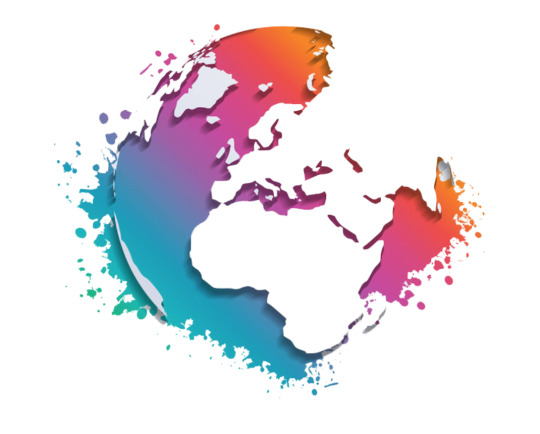
Well..I have been thinking a lot about how several companies tend to work in silos - and I wonder, “Can we break physical barriers by committing to collaboration in digital spaces?” or “How can we use technology to feel better connected to our colleagues at work, even if they are across the country?”
I have also been thinking a lot about how much I enjoy time AWAY from the actual office. I am not saying that I don’t want to work but more so that if I am continually showing up to sit at the same desk in the same building everyday, when does my creativity and motivation start to suffer? And how can we change our work partners to better foster creativity beyond “collaborative spaces” that tend to be empty within trendy offices today. Can we explore remote work and ways to improve it?
The Future of Work is a relevant topic for me because I work in the Ed Tech space with a company that focuses on delivering high quality degrees online, with digital tools and flexibility to students. Exploring the future of work through technology, flexibility, and societal happiness will also help me explore the future of online education. I would love to transition into the product development side of the business and exploring this topic may help point me in the right direction.
Lastly, what better way to explore this problem and its possible solutions through a group that is forced to collaborate digitally. Can we pull from our own experiences and form a product that would make collaboration on a project this size easier? I am excited to use the reflections of my own work life to build upon creative ideas for improving it.
0 notes